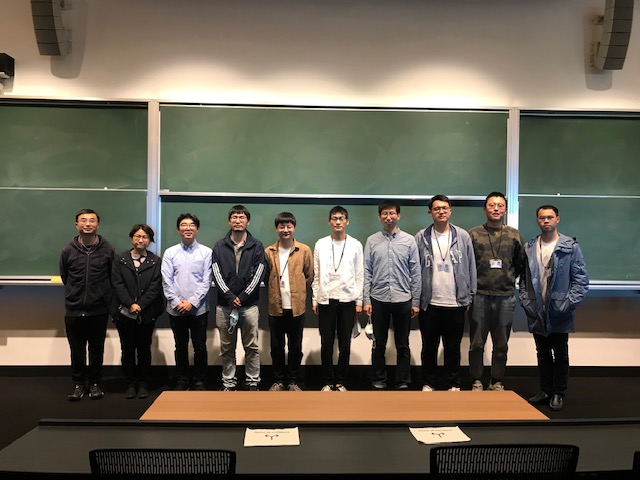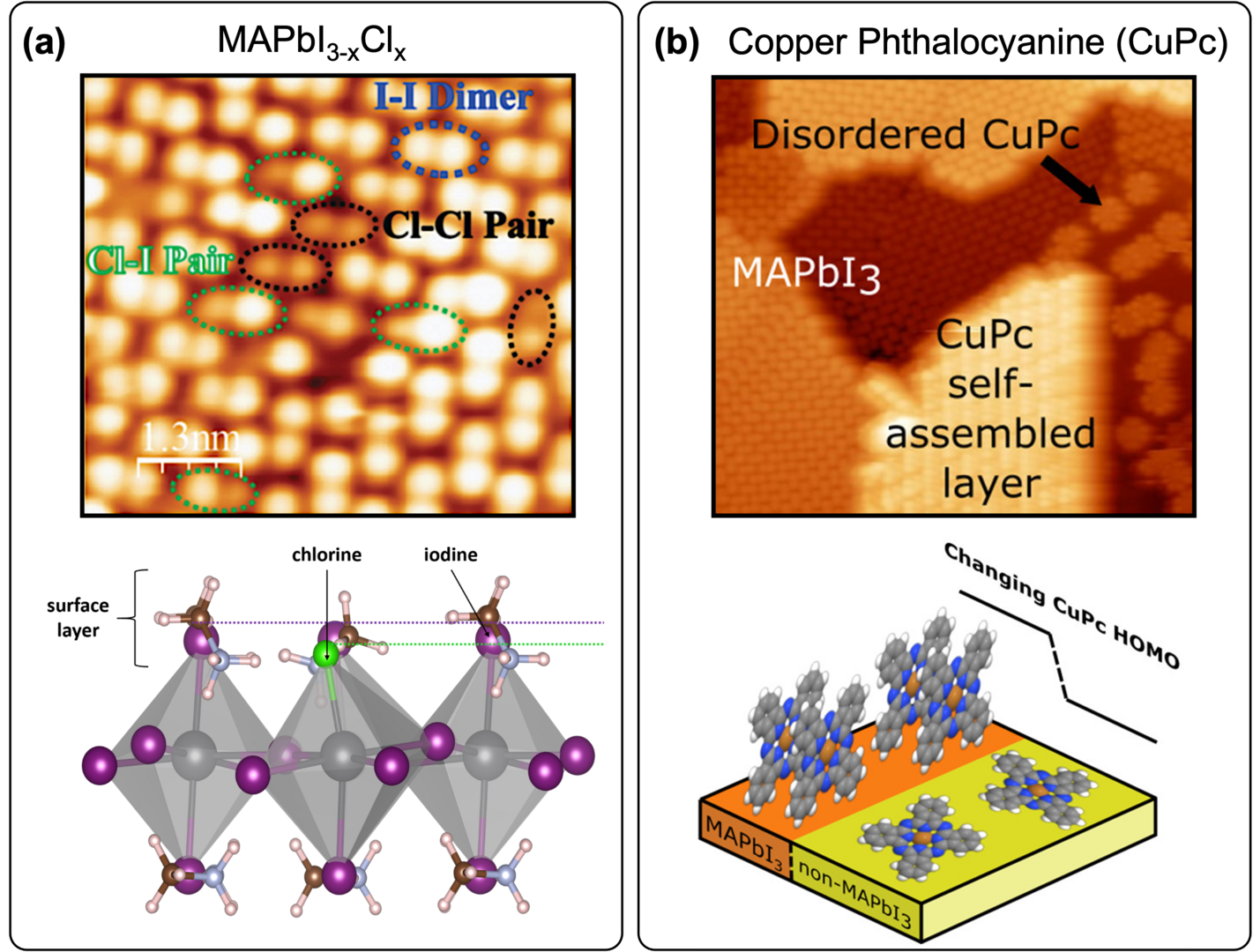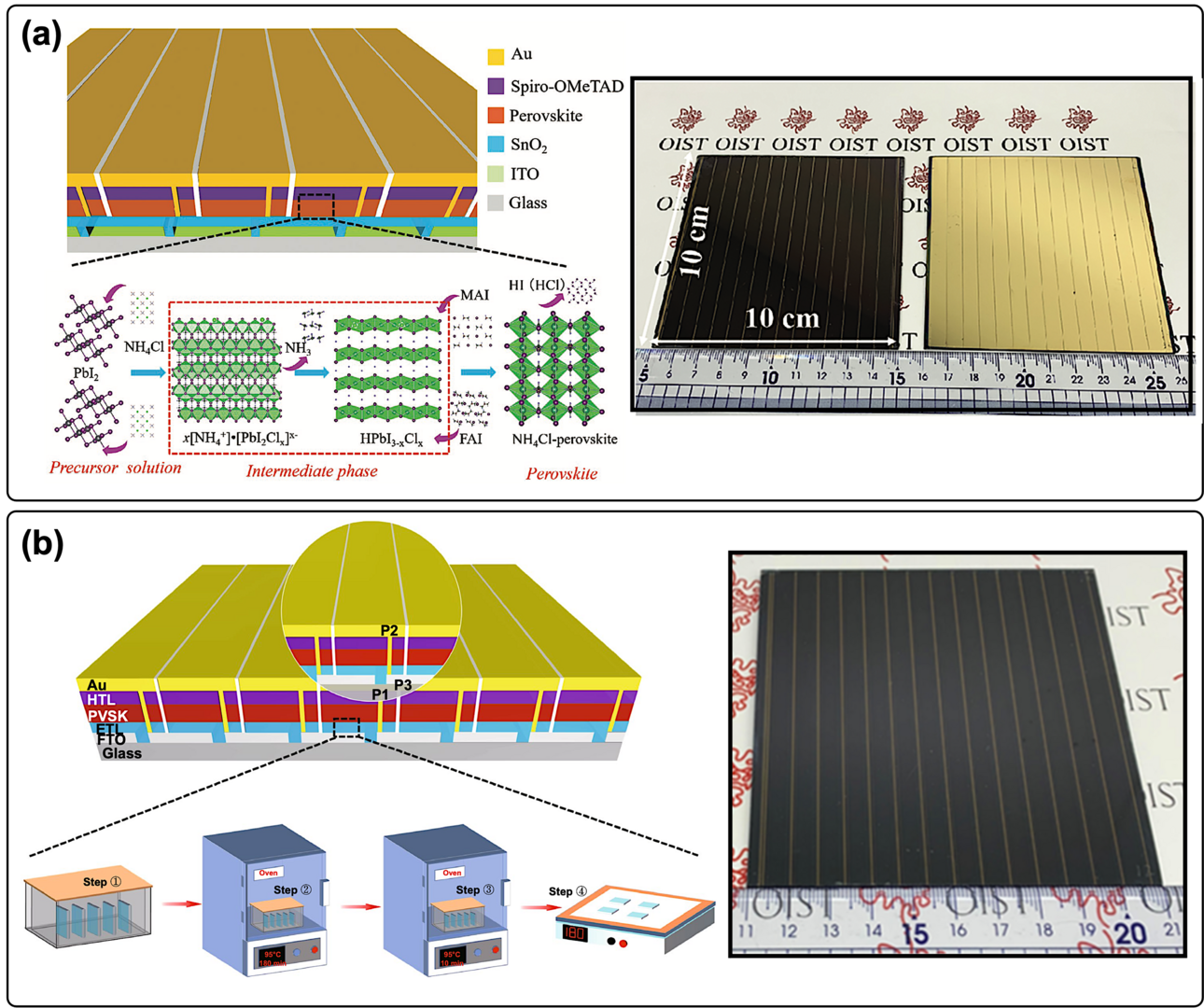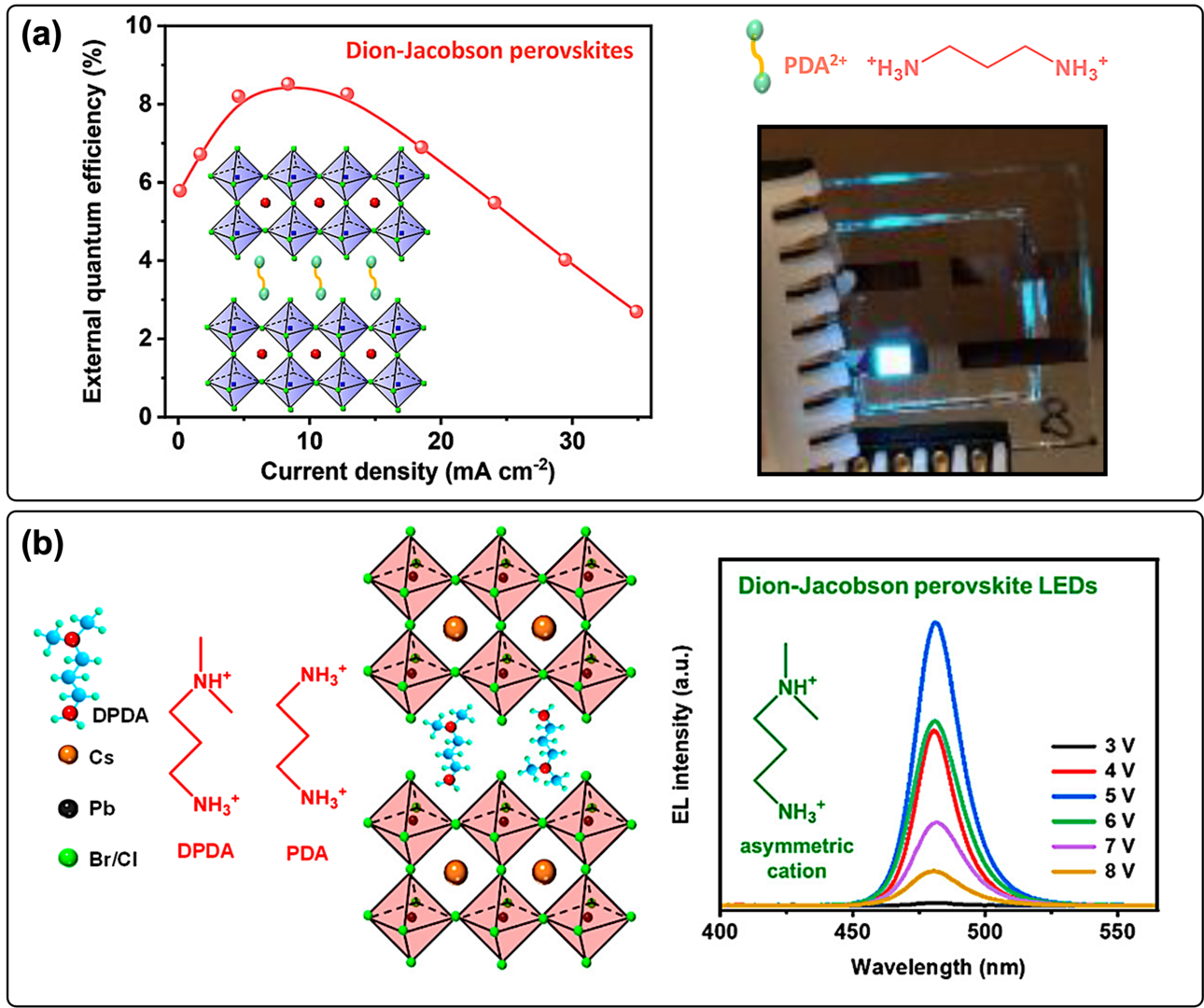FY2021 Annual Report
Energy Materials and Surface Sciences Unit

Abstract
Solar energy harvesting devices based on metal halide perovskites are currently one of the most promising photovoltaic (PV) technologies. However, the commercialization of any PV technologies requires a low-cost with large-area fabrication processes (e.g., referred to the levelized cost of energy (LCOE)) as well as warranty of the product's lifetime (e.g., >20 years is achieved for conventional crystalline-silicone). In this report, we summarize our recent findings on (Section 3.1) the real-space visualization of perovskite surfaces and interfaces at the atomic scale by scanning tunneling microscopy (STM) supported by density functional theory (DFT) calculations to investigate the underlying fundamental properties when the CH3NH3PbI3 perovskite is doped with Cl and when it is in contact with copper phtalocyanine, a hole transport material employed in perovskite solar cells. (Section 3.2) We continued to develop alternative up-scalable fabrication strategies of perovskite solar modules (10 × 10 cm2) with efficiencies of 10.25% also exhibiting good operational stability with a T80 lifetime exceeding 1100 h. (Section 3.3) Fabrication of blue color perovskite light emitting diodes based on Dion-Jacobson phase CsPb(Br/Cl)3 perovskites. (Section 3.4) Continuous utilization of electricity generated from the intermittent solar cells is another important research topic. Development of low-cost and efficient electrical energy storage systems (e.g. Li-ion, Li-sulfur batteries, and other related technologies) combined with solar modules will play a pivotal role in the future use of non-intermittent solar energy harvesting-storage devices.
1. Unit Members
• Ms. Naoko Ogura-Gayler, Research Unit Administrator
• Dr. Luis K. Ono, Group Leader
• Dr. Guoqing Tong, Researcher
• Dr. Hui Zhang, Researcher
• Dr. Yuiqiang Liu, Researcher
• Dr. Tongle Bu, Researcher
• Dr. Wei Zhang, Researcher
• Dr. Chenfeng Ding, Researcher
• Dr. Congyang Zhang, Researcher
• Dr. Tianhao Wu, Researcher
• Dr. Silvia Mariotti, Researcher
• Ms. Afshan Jamshaid, OIST Graduate Student
• Mr. Jiahao Zhang, OIST Graduate Student
2. Collaborations
- Large-Area Formamidinium-Cesium Perovskite by Slot-Die Coating - Sci. Adv. 7, eabg3749 (2021).
- Type of collaboration: collaborative research
- Collaborators:
- Prof. Zonghao Liu, Huazhong University of Science and Technology (HUST), China.
- Prof. Liyuan Han, Shanghai Jiao Tong University, China.
- Prof. Wei Chen, Huazhong University of Science and Technology (HUST), China.
- Lead Halide-Templated Crystallization for Photovoltaic Modules - Science 372, 1327-1332 (2021).
- Type of collaboration: collaborative research
- Collaborators:
- Prof. Fuzhi Huang, Wuhan University of Technology, China.
- Micro-Texture for Fluorescent Anti-Counterfeiting Labels - Small 17, 2100244 (2021).
- Type of collaboration: collaborative research
- Collaborators:
- Prof. Yuexing Han, Shanghai University, China.
- Prof. Jinbo Wu, Shanghai University, China.
- 2D materials for conducting holes from grain boundaries in perovskite solar cells - Light: Sci Appl. 10, 68 (2021).
- Type of collaboration: collaborative research
- Collaborators:
- Prof. Feng Yan, The Hong Kong Polytechnic University, Hong Kong, China.
3. Activities and Findings
3.1 Surface science studies on metal halide perovskites.
Afshan Jamshaid†, Zhendong Guo†, Jeremy Hieulle, Collin Stecker, Robin Ohmann, Luis K Ono, Longbin Qiu, Guoqing Tong, Wanjian Yin*, Yabing Qi*, "Atomic-Scale Insight into the Enhanced Surface Stability of Methylammonium Lead Iodide Perovskite by Controlled Deposition of Lead Chloride" Energy Environ. Sci. 14, 4541-4554 (2021) († equal contribution)
Collin Stecker†, Zhenyu Liu†, Jeremy Hieulle, Siming Zhang, Luis K Ono, Guofeng Wang*, Yabing Qi*, "Atomic Scale Investigation of the CuPc–MAPbX3 Interface and the Effect of Non-Stoichiometric Perovskite Films on Interfacial Structures" ACS Nano 15, 14813-14821 (2021) († equal contribution)
Metal halide perovskites are currently a major topic of research in thin film photovoltaics due to their high power conversion efficiency (PCE) achieved by low-cost fabrication processes. Investigation of perovskite materials at the atomic scale is imperative to determine the underlying fundamental dynamics taking place within the perovskite material as well as during solar cell operation. In one of the studies (Figure 1a), using scanning tunneling microscopy (STM) in combination with density functional theory (DFT) and molecular dynamics (MD) calculations, we have determined the atomic scale real space structure of Cl incorporated CH3NH3PbI3 (MAPbI3) surfaces. At the surface, the concentration ratio of [Cl] : ([Cl] + [I]) is 14.8 +/- 0.6%, which also corresponds to the highest surface stability of Cl-doped MAPbI3 from the viewpoint of both thermodynamics and kinetics according to DFT and MD calculations. Our atomic-scale study of perovskites offers more insights into the Cl-induced property changes in perovskite materials and devices. In another study (Figure 1b), the interface between MAPbI3 and copper phthalocyanine (CuPc), a hole transport layer (HTL), was studied at the atomic scale by STM combined with DFT revealing that CuPc deposited on perovskites form a self-assembled layer consistent with the α-polymorph of CuPc. STM images show a distinctly different adsorption orientation for CuPc on non-perovskite domains of the thin film samples. These findings highlight the effect of non-stoichiometric films on the orientation at the perovskite/HTL interface. Our works highlight the importance of understanding the surface doping effects and interfacial structures.

Figure 1: (a) Scanning tunneling microscopy (STM) image and atomic structure calculation based on density functional theory (DFT) of perovskite surface doped with chlorine. The dark depressions correspond to chlorine (Cl) within the crystal lattice, by replacing with iodine (I). (b) Overview of STM image featuring MAPbI3 and non-MAPbI3 domains after CuPc deposition. Different orientations of CuPc molecules are seen depending on the perovskite and non-perovskite domains where it is adsorbed.
3.2 Up-scalable fabrication strategies of perovskite solar modules.
Guoqing Tong, Dae-Yong Son, Luis K. Ono, Yuqiang Liu, Yanqiang Hu, Hui Zhang, Afshan Jamshaid, Longbin Qiu, Zonghao Liu, Yabing Qi*, "Scalable fabrication of >90 cm2 perovskite solar modules with >1000 h operational stability based on the intermediate phase strategy" Adv. Energy Mater. 11, 2003712 (2021)
Guoqing Tong, Dae-Yong Son, Luis K Ono, Hyung-Been Kang, Sisi He, Longbin Qiu, Hui Zhang, Yuqiang Liu, Jeremy Hieulle, Yabing Qi*, "Removal of residual compositions by powder engineering for high efficiency formamidinium-based perovskite solar cells with operation lifetime over 2000 h" Nano Energy 87, 106152 (2021).
Guoqing Tong, Luis K Ono, Yuqiang Liu, Hui Zhang, Tongle Bu, Yabing Qi*, "Up-Scalable Fabrication of SnO2 with Multifunctional Interface for High Performance Perovskite Solar Modules" Nanomicro Lett. 13, 115 (2021).
In addition to high efficiencies, upscaling and long-term operational stability are key pre-requisites for moving perovskite solar cells (PSCs) toward commercial applications. Several strategies to fabricate large-area uniform and dense perovskite films were developed. In one of the studies (Figure 2a), a two-step coating process by introducing NH4Cl as an additive in the PbI2 precursor solution was developed leading to perovskite film with a thickness over one-micrometer. Incorporation of NH4Cl induces the formation of the intermediate phases of x[NH4+]·[PbI2Clx]x− and HPbI3−xClx, which can effectively retard the crystallization rate of perovskite leading to uniform and compact full-coverage perovskite films. The 10 × 10 cm2 perovskite solar modules (PSMs) based on this method achieved a PCE of 10.25%. These PSMs also exhibit good operational stability with a T80 lifetime under continuous light illumination exceeding 1100 h.
In another study (Figure 2b), we reported on the preparation of high-quality large-area SnO2 films by chemical bath deposition (CBD) with the addition of KMnO4. The strong oxidizing nature of KMnO4 promotes the conversion from Sn(II) to Sn(VI), leading to reduced trap defects and high carrier mobility of SnO2. In addition, K ions diffuse into the perovskite films resulting in larger grain sizes with passivated grain boundaries and reduced hysteresis of PSCs. Furthermore, Mn ion doping improves both the crystallinity and the phase stability of the perovskite films. Such a multifunctional interface engineering strategy enabled us to fabricate 10 × 10 cm2 PSMs with PCE of 11.80% (active area PCE = 13.72%). For the encapsulated PSM, we obtained a T80 operation lifetime exceeding 1000 h in lab ambient condition (25 oC, 50% relative humidity).

Figure 2: (a) Summary of the formation process of the NH4Cl-based perovskite films starting from NH4Cl and PbI2 precursors leading to the intermediate phases of x[NH4+]·[PbI2Clx]x− and HPbI3−xClx. Illustration of PSM architecture with substrate area 10 × 10 cm2. (b) Schematic illustration of the SnO2 films fabricated by chemical bath deposition (CBD) and the 10 × 10 cm2 PSM.
3.3 Metal halide perovskite materials in light-emitting diodes.
Yuqiang Liu, Luis K. Ono, Guoqing Tong, Hui Zhang, Yabing Qi*, "Two-dimensional dion-jacobson structure perovskites for efficient sky-blue light-emitting diodes" ACS Energy Lett. 6, 908-914 (2021).
Yuqiang Liu, Luis K Ono, Guoqing Tong, Tongle Bu, Hui Zhang, Chenfeng Ding, Wei Zhang, Yabing Qi*, "Spectral Stable Blue-Light-Emitting Diodes via Asymmetric Organic Diamine Based Dion–Jacobson Perovskites" J. Am. Chem. Soc. 143, 19711–19718 (2021).
Congyang Zhang, Qun Wan, Luis K Ono, Yuqiang Liu, Weilin Zheng, Qinggang Zhang, Mingming Liu, Long Kong, Liang Li*, Yabing Qi*, "Narrow-Band Violet-Light-Emitting Diodes Based on Stable Cesium Lead Chloride Perovskite Nanocrystals" ACS Energy Lett. 6, 3545-3554 (2021).
Perovskite materials possess desirable optoelectronic properties and are also promising candidates in the field of displays and light sources. In one of the studies (Figure 3a), we reported the use of Dion-Jacobson (DJ) phase perovskites for fabricating efficient sky-blue perovskite light emitting diodes (LEDs). Organic diamine propane-1,3-diammonium cations were iincorporated into CsPbBr3 leading to DJ phase perovskites. RbBr was further incorporated as a passivation agent to eliminate traps. It was found that diamine cations and RbBr are interdependent in terms of increasing the utilization of charges. Radiative recombination was enhanced, effectively benefiting from the synergetic confinement and passivation effects. The photoluminescence quantum yield approached 70%. Finally, the fabricated perovskite LEDs achieved an external quantum efficiency of 8.5% with an emission peak at 490 nm. In a consecutive study (Figure 3b), we reported a new type of DJ phase CsPb(Br/Cl)3 perovskite via introduction of an asymmetric molecular configuration as the organic spacer cation in perovskites. The primary and tertiary ammonium groups on the asymmetric cations bridge with the lead halide octahedra forming the DJ phase structures. Stable photoluminescence spectra were demonstrated in perovskite films owing to the suppressed halide segregation. Meanwhile, the radiative recombination efficiency of charges was improved significantly as a result of the confinement effects and passivation of charge traps. Finally, we achieved an external quantum efficiency of 2.65% in blue PeLEDs with stable spectra emission under applied bias voltages. To our best knowledge, this is the first report of asymmetric cations used in PeLEDs, which provides a facile solution to the halide segregation issue in PeLEDs.

Figure 3: (a) Schematic illustration of the 2D DJ phase perovskites. The photograph shows the perovskite LED under 4 V bias. (b) Schematic illustration of the DJ phase perovskites and the chemical structure of the DPDA and PDA organic cations. Electroluminescence spectra of the devices with DPDA as the organic cations.
3.4 Progress on low-cost efficient energy storage devices.
Hui Zhang, Luis K. Ono , Guoqing Tong, Yuqiang Liu, Yabing Qi*, "Long-life lithium-sulfur batteries with high areal capacity based on coaxial CNTs@TiN-TiO2 sponge" Nat. Commun. 12, 4738 (2021).
Taehoon Kim, Dae-Yong Son, Luis K Ono, Yan Jiang, Yabing Qi*, "A solid-liquid hybrid electrolyte for lithium-ion batteries enabled by a single-body polymer/indium tin oxide architecture" J. Phys. D Appl. Phys. 54, 475501 (2021).
Based on the high theoretical energy density (2,600 Wh kg-1), lithium-sulfur (Li-S) batteries are promising candidates that meets the demand of high-energy rechargeable batteries. However, the shuttling effect of lithium polysulfides causes fast capacity fading and poor cycle life, which impedes the practical applications of Li–S batteries. In our studies (Figure 4a), we utilize the atomic layer deposition (ALD) method to fabricate a coaxial carbon nanotubes (CNTs) coated with titanium nitride (TiN) and titanium dioxide (TiO2) layers designated as CNTs@TiN–TiO2 sponges. The optimized conditions of 10 nm of TiN wrapped by 5 nm of TiO2 exhibited excellent ability to improve the Li–S battery performance with a high specific capacity of 1431 mAh g−1 at 0.2 C and high capacity retention of 85% after 500 cycles at 2 C. The main reason is that the continuous interface within the TiN–TiO2 heterostructure makes TiO2 adsorb lithium polysulfides first and then readily diffuses the polysulfides to TiN to proceed with the subsequent electro-chemical catalysis. As a result, the areal capacity of the Li–S battery based on the coaxial CNTs@TiN–TiO2 sponge reached up to 21.5 mAh cm−2.
Development of solid-state electrolytes is important because of their high safety and cycling stability for lithium ion batteries. However, the interfacial contact issue of solid electrolytes with the electrode and active material hinders their practical use. In our studies (Figure 4b), we demonstrated a hybrid electrolyte that combines a solid polyethylene terephthalate (PET) electrolyte with an organic liquid electrolyte. The single-body PET electrolyte/In2O3–SnO2 (ITO; 110 nm, 150 nm, 260 nm and 340 nm) electrode was prepared by vacuum sputtering deposition. The simplicity of the electrode composite (e.g., conductive additive-free, solvent-free and binder-free) and its gapless structure between the polymer substrate and the active material significantly impede the formation of by-products from the decomposed electrolyte as well as the growth of an unstable solid electrolyte interphase upon cycling. The hybrid electrolyte cell shows an excellent rate capability at 100–400 mA g−1 and a high cycling stability (>1200 cycles). Our study demonstrates the feasibility of practical hybrid electrolytes for lithium ion batteries with improved stability.

Figure 4: (a) Schematic illustration showing the fabrication process of CNTs@TiN–TiO2 through the atomic layer deposition (ALD) method and its catalytic process for the polysulfide conversion. Cyclic stability comparison after 100 cycles at 0.2 C. (b) Long-term cycling performance of CNTs@TiN–TiO2 at 1 C. (b) Schematic drawing showing the conventional lithium ion battery electrode and newly developed PET electrolyte/ITO electrodes (PITO) and battery performances.
3.5 Review articles
Longbin Qiu*, Sisi He, Yan Jiang*, Yabing Qi*, "Metal Halide Perovskite Solar Cells by Chemical Vapor Deposition" J. Mater. Chem. A 9, 22759-22780 (2021).
Yan Jiang*, Yabing Qi*, "Metal halide perovskite-based flexible tandem solar cells: next-generation flexible photovoltaic technology" Mater. Chem. Front. 5, 4833-4850 (2021).
Helian Sun, Pengfei Dai, Xiaotong Li, Jinyan Ning, Shenghao Wang, Yabing Qi*, "Strategies and methods for fabricating high quality metal halide perovskite thin films for solar cells" J. Energy Chem. 60, 300-333 (2021).
Zhichun Yang, Zonghao Liu*, Vahid Ahmadi, Wei Chen, Yabing Qi*, "Recent Progress on Metal Halide Perovskite Solar Minimodules" Solar RRL 2100458 (2021).
Tianhao Wu, Xing Li, Yabing Qi*, Yiqiang Zhang, Liyuan Han*, "Defect Passivation for Perovskite Solar Cells: from Molecule Design to Device Performance" ChemSusChem 14, 4354-4376 (2021).
Wei Zhang, Luis K Ono, Jiamin Xue, Yabing Qi*, "Atomic Level Insights into Metal Halide Perovskite Materials by Scanning Tunneling Microscopy and Spectroscopy" Angew. Chem. Int. Ed. 134, e202112352 (2021).
Jia Liang, Yabing Qi*, "Recent progress on all-inorganic metal halide perovskite solar cells" Mater. Today Nano 16, 100143 (2021).
4. Publications
4.1 Journals
→Please see our publications page for published journals
4.2 Books and Other One-Time Publications
N/A
4.3 Oral and Poster Presentations
(1) Y. B. Qi, “Surface science studies on metal halide perovskite materials and solar cells”, The 13th International Workshop on Oxide Surfaces: IWOX-XIII, Korea (January 9-14, 2022) (Invited talk).
(2) Y. B. Qi, “Surfaces and interfaces in metal halide perovskite solar cell devices”, Chemical Society of Japan Festa Conference (CSJ Festa) (October 19-21, 2021) (Invited talk).
(3) Y. B. Qi, “Surface science in metal halide perovskite materials and devices”, SPIE/COS Photonics Asia conference on "Photonics for Energy” (October 10-12, 2021), Nantong, China (Invited talk).
5. Intellectual Property Rights and Other Specific Achievements
Y. B. Qi, H. Zhang, L. K. Ono. “Long-life lithium-sulfur batteries”, US patent application (Year of application: 2021)
6. Meetings and Events (need to edit)
N/A



